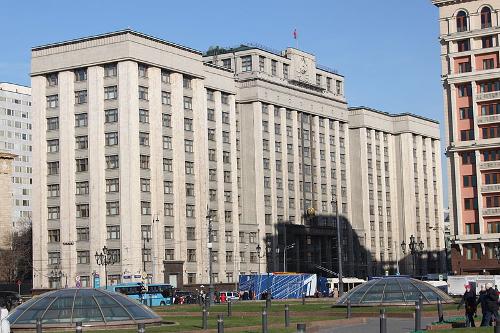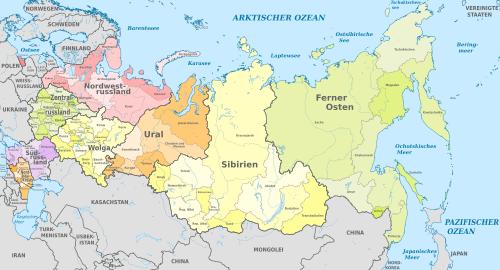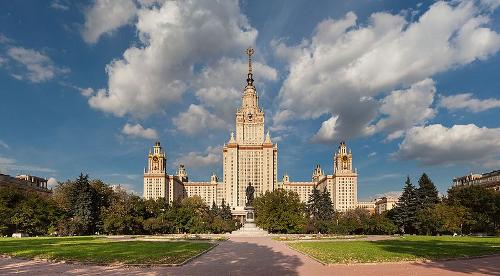RUSSIA
Society

Society
Cities in RUSSIA
| Moscow | Saint-petersburg |
Society
State Structure
 Duma RussiaPhoto: Moscowjob.net CC 4.0 International no changes made
Duma RussiaPhoto: Moscowjob.net CC 4.0 International no changes made
The president, now Putin, plays a crucial role in the political system of the Russian Federation. For example, the president appoints the prime minister (with the consent of the House of Representatives, the "Duma") and he can defeat the government or individual members thereof at any time. The latter happens very regularly. Furthermore, the president can promulgate far-reaching legislative measures outside parliament by means of decrees and orders. He is also the commander in chief of the army and responsible for domestic and foreign policy. An important body like the national Security Council is directly answerable to the president, and the secretary is again appointed by the president. In theory, it is possible for parliament to remove the president from office, but in practice this is almost impossible. The president may serve a maximum of two four-year terms and is elected by universal suffrage.
The State Duma ("Lower House") consists of 450 deputies and is elected every four years by universal suffrage. The voters may then cast two votes: one vote for a regional candidate and one vote for a national candidate for a particular party.
The Federation Council ("Senate") has 178 members and consists of two representatives from all 89 administrative units. Each region is intended to delegate the region's governor or president, along with someone elected by the regional parliament. For the current political situation see chapter history.
Administrative division
 Map of administrative divisions of RussiaPhoto: TUBS CC 3.0 Unported no changes made
Map of administrative divisions of RussiaPhoto: TUBS CC 3.0 Unported no changes made
The Russian Federation is not a real Federation, but is based on the idea of the united state, with a certain autonomy for a number of areas. The territory is divided into 21 (sub ) republics , one autonomous region, six regions or border areas (krajs), ten autonomous districts (okrug), two federal cities (Moscow and Saint Petersburg) and 49 districts (oblasts). The Republic of Chechnya ,formerly part of the Soviet republic of Checheno-Ingusetia, declared itself unilaterally independent in 1991. Most republics and also the provinces are divided into districts (rajons). The republics have a constitution which is very similar to that conducted by the federation, provinces and other local governing bodies by directly elected soviets or Duma, with the local administration and governing body. Furthermore exist at lower levels also autonomous regions and other national entities, such as national districts, towns and villages .
In 2000, all republics and provinces were subdivided into seven federal districts, which do not form a separate administrative layer, but serve to strengthen federal control over the decentralized administration. Each federal district is headed by a representative of the president . The seven districts are: North-West, Central, Caucasus, Volga, Ural, Siberia and the Far East.
Republics:
| Republic | Area | Population |
| Adygië | 7600 km2 | 449.000 |
| Alanië | 8000 km2 | 664.000 |
| Altaj | 92.600 km2 | 202.000 |
| Basjkirië | 143.600 km2 | 4.134.000 |
| Boerjatië | 351.300 km2 | 1.050.000 |
| Chakassië | 61.900 km2 | 584.000 |
| Dagestan | 50.300 km2 | 2.121.000 |
| Ingoesjetië | 2.700 km2 | 190.000 |
| Kabarda-Balkarië | 12.500 km2 | 789.000 |
| Kalmukkië | 76.100 km2 | 317.000 |
| Karatsjajevo-Tsjerkessië | 14.100 km2 | 436.000 |
| Karelië | 172.400 km2 | 780.000 |
| Komi | 415.900 km2 | 1.172.000 |
| Mari | 23.200 km2 | 764.000 |
| Mordovië | 26.200 km2 | 950.000 |
| Oedmoertië | 42.100 km2 | 1.636.000 |
| Sacha | 3.103.200 km2 | 1.093.000 |
| Tatarstan | 68.000 km2 | 3.763.000 |
| Toevinië | 170.500 km2 | 310.000 |
| Tsjetsjenië | 16.600 km2 | 862.000 |
| Tsjoevasië | 18.300 km2 | 1.359.000 |
Autonomous area
Birobidjan (Jewish autonomous 36,000 km2 216,000 area)
Autonomous regions (okroegi)
| Region | Area | Population |
| Aginski-Boerjatski | 19.000 km2 | 78.000 |
| Evenki | 768.000 km2 | 25.000 |
| Jamalo-Neneti | 750.000 km2 | 493.000 |
| Khantys-Mansts | 523.000 km2 | 1.314.000 |
| Komi-Permjak | 30.000 km2 | 160.000 |
| Korjaki | 302.000 km2 | 40.000 |
| Neneti | 178.000 km2 | 55.000 |
| Oest-Ordynski | 20.000 km2 | 138.000 |
| Tajmyr (Dolgano-Neneti) | 862.000 km2 | 54.000 |
| Tsjoektsji | 738.000 km2 | 87.000 |
Federal cities city population
Moscow - 8,300,000
Saint Petersburg - 4,700,000
Districts (oblasti)
| Districten | Oppervlakte | Population |
| Amur Oblast | 363.700 km2 | 905.000 |
| Arkhangelsk Oblast | 587.400 km2 | 1.340.000 |
| Astrakhan Oblast | 44.100 km2 | 1.005.000 |
| Belgorod Oblast | 27.100 km2 | 1.511.000 |
| Bryansk Oblast | 34.900 km2 | 1.375.000 |
| Chelyabinsk Oblast | 87.900 km2 | 3.605.000 |
| Chita Oblast | 431.500 km2 | 1.155.000 |
| Irkutsk Oblast | 767.900 km2 | 2.770.000 |
| Ivanovo Oblast | 21.400 km2 | 1.150.000 |
| Kaliningrad Oblast | 15.000 km2 | 970.000 |
| Kaluga Oblast | 29.900 km2 | 1.045.000 |
| Kamchatka Oblast | 472.300 km2 | 360.000 |
| Kemerovo Oblast | 95.700 km2 | 2.900.000 |
| Kirov Oblast | 120.800 km2 | 1.505.000 |
| Kostroma Oblast | 60.200 km2 | 740.000 |
| Kurgan Oblast | 71.500 km2 | 1.020.000 |
| Kursk Oblast | 29.800 km2 | 1.235.000 |
| Leningrad Oblast | 85.900 km2 | 1.670.000 |
| Lipetsk Oblast | 24.100 km2 | 1.215.000 |
| Magadan Oblast | 461.400 km2 | 185.000 |
| Moscow Oblast | 45.000 km2 | 6.620.000 |
| Murmansk Oblast | 144.900 km2 | 895.000 |
| Nizhny Novgorod Oblast | 76.900 km2 | 3.525.000 |
| Novgorod Oblast | 53.895 km2 | 685.000 |
| Novosibirsk Oblast | 178.200 km2 | 2.695.000 |
| Omsk Oblast | 139.700 km2 | 2.080.000 |
| Orenburg Oblast | 124.000 km2 | 2.180.000 |
| Oryol Oblast | 24.700 km2 | 865.000 |
| Penza Oblast | 43.300 km2 | 1.450.000 |
| Perm Oblast | 160.600 km2 | 2.820.000 |
| Pskov Oblast | 55.400 km2 | 750.000 |
| Rostov Oblast | 100.800 km2 | 4.405.000 |
| Ryazan Oblast | 39.600 km2 | 1.230.000 |
| Sakhalin Oblast | 87.100 km2 | 550.000 |
| Samara Oblast | 53.600 km2 | 3.240.000 |
| Saratov Oblast | 100.200 km2 | 2.670.000 |
| Smolensk Oblast | 49.786 km2 | 1.050.000 |
| Sverdlovsk Oblast | 194.800 km2 | 4.490.000 |
| Tambov Oblast | 34.539 km2 | 1.160.000 |
| Tomsk Oblast | 316.900 km2 | 1.060.000 |
| Tula Oblast | 25.700 km2 | 1.680.000 |
| Tver Oblast | 84.586 km2 | 1.445.000 |
| Tyumen Oblast | 1.435.200 km2 | 3.265.000 |
| Ulyanovsk Oblast | 37.300 km2 | 1.385.000 |
| Vladimir Oblast | 29.000 km2 | 1.525.000 |
| Volgograd Oblast | 114.100 km2 | 2.700.000 |
| Vologda Oblast | 145.700 km2 | 1.270.000 |
| Voronezh Oblast | 52.400 km2 | 2.380.000 |
| Yaroslavl Oblast | 36.400 km2 | 1.370.000 |
Regions (krajs)
169.100 km2
| Region (kraj) | area | population |
| Altai Krai | 2.600.000 | |
| Khabarovsk Krai | 788.600 km2 | 1.160.000 |
| Krasnodar Krai | 76.000 km2 | 5.130.000 |
| Krasnoyarsk Krai | 2.403.520 km2 | 3.700.000 |
| Primorsky Krai | 165.900 km2 | 2.305.000 |
| Stavropol Krai | 66.500 km2 | 2.680.000 |
Education
 Main building of Moscow State University in MoscowPhoto: Dmitry A. Mottl CC 3.0 Unported no changes made
Main building of Moscow State University in MoscowPhoto: Dmitry A. Mottl CC 3.0 Unported no changes made
In Russian schools, all age groups are usually present at one educational institute. Children are obliged to go to school from the age of six to seventeen, starting with the so-called 1st department, grades 1 to 4.
Then they go on to department 2, grades 5 to 9 of the secondary Education. In this department, a package of subjects is followed that is already tailored to personal preference and aptitude.
Finally, there are grades 10 and 11 in the 3rd department of secondary education. All children receive the compulsory curriculum here, including Russian literature, mathematics, physics, astronomy, a modern language and physical education.
Higher education in Russia is provided at universities, institutes and academies. Both vocational and university programs are offered at all institutions. Universities provide programs in various disciplines, more recently in agriculture, medicine and technology.
In addition, there are hundreds of institutes in Russia that provide training for regulated professions in a number of disciplines. This includes agricultural, pharmaceutical, medical, pedagogical, and technical institutes. In recent years these institutes have often been given the status of universities. Academies provide training in one discipline.
The first two years of higher education studies are broadly oriented, with subjects such as mathematics, physics, chemistry and languages. The last two or three years are devoted to a specialization: and then one is not trained as a general structural engineer, but for example as a specialist in refrigeration technology.
Sources
Graaf, A. van der / Reis-handboek Sovjet-Unie
Elmar
Rusland, Centraal-Azië en de Kaukasus
The Reader’s Digest,
Russia & Belarus
Lonely Planet
Te gast in Rusland
Informatie Verre Reizen
CIA - World Factbook
BBC - Country Profiles
Copyright: Team The World of Info